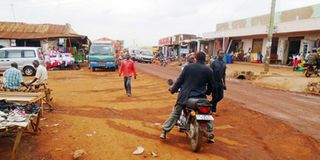What is behind Uganda’s urbanisation ?

Urbanisation. Bukolooto Trading Centre, one of the undeveloped business centres in Kayunga District. PHOTO BY FRED MUZAALE
What you need to know:
- Uganda is urbanising at a rate of 5 per cent per annum, according to the National Development Plan II
The urban growth rate in Africa is 11 times more rapid than the growth rate in Europe, according to the World Cities Report 2016. - In this article, the we look at transformation of a trading centre, what is taken into consideration in declaring an area an urban centre, challenges associated with urban centres and possible solutions, writes Nelson Wesonga
Shops line what two decades ago was an open ground in Waluga village, Katoogo Parish in Nama Sub-county, Mukono District.
Behind the shops are tenements on what were gardens. More tenements are being built. “Twenty years ago, the people who were living here were indigenes,” Waluga’s Local Council 1 chairperson Sulaiman Katambala, 50, says.
“Then, you could buy a fifty by a hundred plot of land for between Shs500,000 and Shs800,000. Such a plot now costs between Shs8 million and Shs10 million.” Katoogo is one of the trading centres that are exhibiting the characteristics common to urban centres.
The population in such centres is increasing. Also, as would happen with mushrooms after rain, more buildings are sprouting. Where there was neither a primary nor a secondary school, such centres now have at least one or two schools and health centres. They have police posts too.
In the case of Katoogo, National Water and Sewerage Corporation has extended the pipe water network from Mukono Municipality to Katoogo, 17 kilometres away. Many of the centres now have active markets where there were none.
What are lacking are electricity and the gazetting of such areas as urban centres, a government call. In the early 1990s, for a trading centre to be called an urban centre, it had to have population of above 1, 000 persons.
Today, an urban centre is one that is gazetted thus. According to the National Population and Housing Census 2014 Main Report, which was released in 2016, the number of urban centres has increased from 67 in 1991, 75 in 2002 and to 259 as of March 2016.
Over that period, the human population in the urban centres has increased from 1.6 million in 1991, 2.9 million in 2002 to 7.4 million (2016).
Urbanisation, which the Uganda Bureau of Statistics defines as the increase in the proportion of the population living in urban areas is attributed to the creation of new administrative units, among other reasons.
Makerere University lecturer Development Studies Ellia Nyanja-Musoke attributes the growth of urban centres to high population growth.
It does not help matters he says that the education curriculum has ‘uprooted the children from the soil’, making them think of migrating from the rural to the urban areas.
“The people who are on the land see it as an opportunity to build anywhere, anyhow so that they can accommodate and milk money from these people [the new arrivals],” Nyanja-Musoke says.
Isaac Musumba Isanga, the State minister for Urban Planning, says urbanisation is a result of the development of social infrastructure, industrialisation and one’s level of education.
He says once roads are constructed, the next time you go to the areas where the roads have been constructed, you will find people have moved in.
“As countries industrialise, people move to areas where factories are located to look for work. And, as people become more educated, they move to the towns in such of better lives,” Mr Musumba adds.
The World Cities Report 2016 says besides the above, Africa’s rapid urbanisation is also driven by negative events such as conflict and disaster.
These two drive people from different parts of, say, districts or countries to areas where the local authorities or the international community then provide some social support or services.
Though not advanced in the World Cities Report, this is what partly contributed to the growth of Adjumani Town in West Nile. The area used to, and still hosts, refugees displaced by the violent conflict, first in the Sudan and after the Sudan split into two, the conflict in South Sudan.
The challenges associated with urbanisation are many. They range from shortage of housing, unemployment, insecurity and strain on the social services.
According to the National Development Plan (NDP) II, the need for new housing for Uganda is estimated at 200,000 annually.
Out of that, 65,000 would be in the urban areas. The plan says the estimated construction rate of reasonably good houses is estimated at 40, 000 units annually in the rural areas and 20,000 in urban areas.
The population growth is 3.4 per cent per annum; urbanisation is at 5.2 per cent annually.
“This will create a deficit of 135,000 houses nationally of which 95,000 are in rural areas and 45,000 in urban areas,” the NDP II says.
Consequently, informal settlements crop up to accommodate the many unemployed people. In such settlements, garbage dots many ‘street’ corners.
“Once they [informal settlements] grow, they are difficult to control because they accommodate many people, people the government fears to touch,” says Nyanja-Musoke.
“Most of the politicians in urban areas have their powerbases in these areas.”
Many of the people in many urban centres are either unemployed or underemployed.
Some of the unemployed turn to crime to get money to get for themselves the basics of life such as food and accommodation.
Where buildings have been erected or are being constructed on tracks of land that previously had crops, the acreage of land for agriculture is reducing.
“In the past, many people had large gardens. Many rich people have since bought much of the land, fenced it off and either put cattle there or planted trees on the land,” Katambala says.
“Farmers here no longer cultivate sweet potatoes and cassava as much as they used to.”
Mr Musumba says in many times people are moving into areas, and populating them before he local authority demarcates the corridors meant for roads, sewer lines or space for public schools and hospitals.
Where social amenities are lacking; it affects the quality of life of the people in that area and their productivity.
Many times when there is an outbreak of, say, Cholera it can be traced to informal settlements, which accommodate comparatively more people per square kilometre yet are short on social service infrastructure.
Given the higher concentration of people, production and consumption in areas, it is associated with climate change, greenhouse gases.
Aside from the problems associated with urbanisation, urban centres are home to hundreds of people who could be a source of cheap labour for cottage industries, plantations or manufacturing concerns nearby.
Still, the government should plan before for urbanisation.
The chairperson of the House Committee on Public Service and Local Government, Raphael Magyezi, says currently the authorities wait for an area to exhibit the characteristics of an urban growth centre to even consider declaring it a town board.
Mr Magyezi adds that Parliament needs to appropriate money to plan them beforehand. Though many districts have planning departments, many of them are understaffed.
Many a district has just one district planner. There have also been suggestions that the population should be checked through birth control.
However, even if every Ugandan from now on says he or she will have one child, you would still have a generation to undo the current large population, currently 34.9 million.
Population control cannot be a quick, short term or medium term solution, Dr Fred Muhumuza, an economist, once said in reference to unemployment.
Aside from checking population, the government plans to control urban sprawl by encouraging by construction of high-rise buildings, and by strict development control.
The government also has to address itself to the failure to enforce the existing physical planning law and regulations.
Mr Musumba says the Cabinet is considering the amendments to the Physical Planning Act, 2010 to allow the central government machinery to be used to help local governments to enforce laws.
In the past, local governments had administration police they would rely on to enforce laws.
However, the government centralised the police.
Now, when need arises, the local governments have to request the central government for the police.
“To get the police to help, there are certain procedures that have to be followed before the police are authorised to...It is a bureaucracy that weakens enforcement,” Mr Musumba says.




